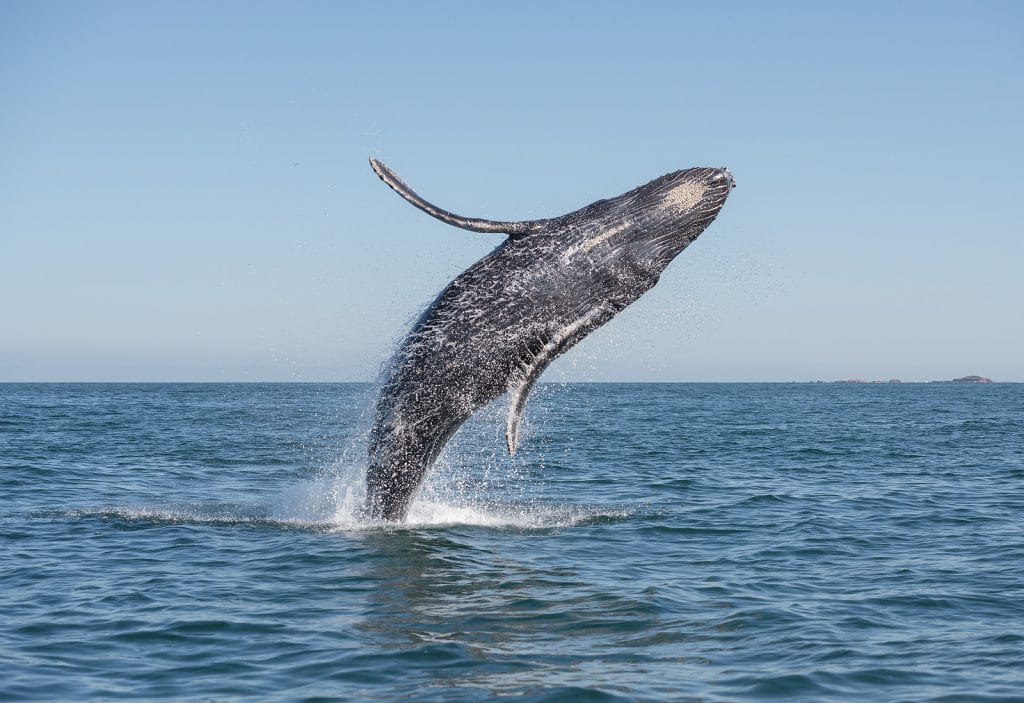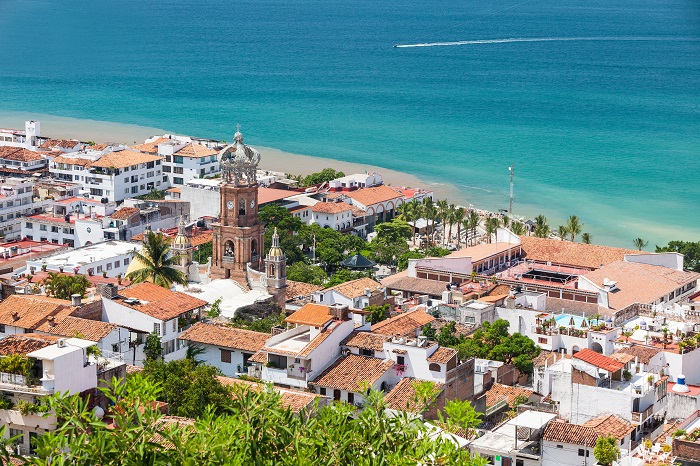If you are looking for a way to reward yourself and your family, there are few rewards better than spending time at your home away from home in Mexico. The winter months make Mexico a favorite vacation spot not only because of the favorable climate and gorgeous beaches, but also because it’s the time of year where you can go whale watching
In the winter season, thousands of humpback whales migrate to Mexico’s coasts to mate and give birth to their young and it’s a once-in-a-lifetime experience that you may want to repeat again and again. Seeing these giant, majestic creatures lobtailing, fin slapping, and breaching is truly breathtaking. While their size may be intimidating – they can grow up to 60 feet long and weigh up to 40 tons – they are actually gentle giants and completely harmless. The most impressive thing about humpback whales, apart from their size, is their navigation capability. They travel around 3,000 miles during their migration all without GPS. They typically travel from Alaska all the way to Mexico’s coastal cities or to Hawaii.
Every year, humpback whales appear in Baja California Sur in early December and some make their way to Puerto Vallarta and the Riviera Nayarit. They reach Baja California first so they are typically spotted here sooner than in Banderas Bay. Sightings in Cabo usually happen in early December while it’s more typical to see them emerge in Jalisco and Nayarit in mid-December. They stay in Puerto Vallarta until late March and then make their way back to Cabo so can still be seen there up until mid-April.
During the winter months, these popular beach destinations become a breeding ground for whales looking to find a mate. The best part is that the male whales tend to compete for females and they do this by performing acrobatic feats in order to impress the female and get her attention. Luckily, spectators out on the water, on the shore, or even on their resort balcony, also get to witness the action involved in their mating game.
Going on a whale watching tour is an activity the whole family will love and it’s educational too. People who go whale watching enjoy a close connection with nature and a change from the day-to-day routine.
Puerto Vallarta
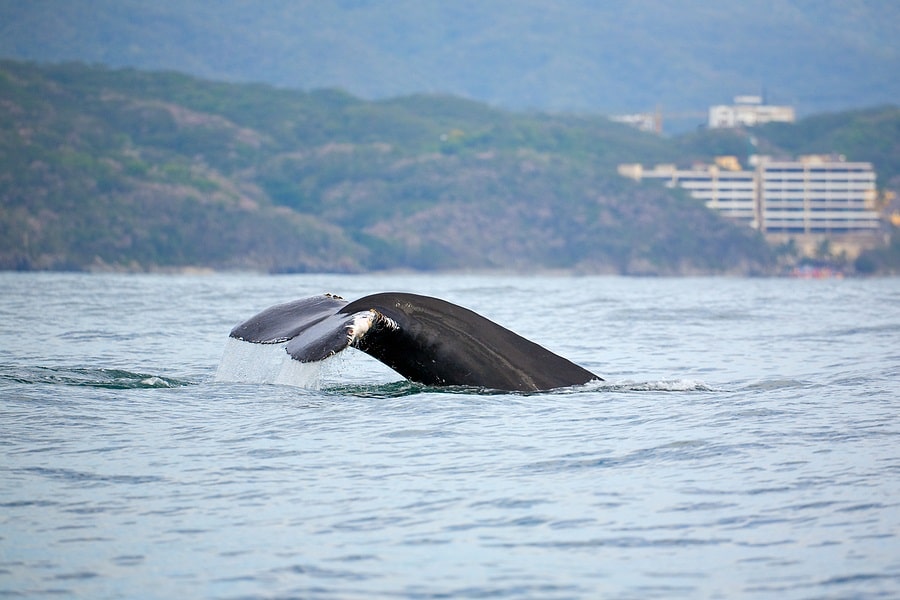
Puerto Vallarta is well-known for its wildlife ecotourism and it has the advantage of the Sierra Madre mountains wrapping around the Banderas Bay. The beach and jungle landscapes are truly alluring, which make it a fabulous playground for tourists and wildlife alike.
Puerto Vallarta’s seas are home to humpback whales. Witness them shooting spouts of water, waving their tales, and rising up from the sea splashing water everywhere also known as breaching. Their size and immense power is truly impressive. What’s more impressive is that while weighing 40 tons, they can still perform acrobatic movements.
During your whale watching tour, you may also spot sea turtles, manta rays, and pods of dolphins. The boats can get pretty close to the whales, anywhere between 60 meters (200 feet)and 80 meters (262 feet), allowing you to take some amazing photos and enjoy a great interaction with them. Sometimes whales can seem as curious about us as we are about them and at times it feels as if they are putting on a show to get attention from the boat passengers.
Remember that if you are vacationing in Puerto Vallarta between mid-December and the end of March, you do not have to book a specific whale watching tour to see whales. If you book any boat tour that leaves early in the morning, you will likely be able to spot whales and the captain of the boat will point them out if there are any nearby. The benefit of going on a whale watching tour is that some tour operators have boats equipped with hydrophones that allow you to listen to whale songs, a complex sequence of noises and rhythms that are incredible to listen to.
Several tour operators offer whale watching tours ranging in duration and price. Check with your Member Services or Pre-Arrival agent prior to your trip about the best option for you and your group. For members staying at Villa del Palmar Puerto Vallarta, the closest marina where the boats depart from is A.P.I. Marina, which sometimes gets confused with Marina Vallarta. The two marinas are located in close proximity to each other but A.P.I. is the marina where most tours depart from. A.P.I. Marina is approx. a 7 minute drive (1.2 miles) from Villa del Palmar Puerto Vallarta.
Family vacations are an excellent opportunity for families to bond through unforgettable experiences, and whale watching is sure to be one of those amazing memories that you’ll often think back on.
Riviera Nayarit

Whale watching is a popular activity in Riviera Nayarit. Depending which tour company you book with, you may go closer to Punta Mita or to Islas Marietas (”Marietas Islands”). Tours vary in length, but the typical tour departs early in the morning and lasts for 4 hours.
Sightings of humpback whales are the most common in Riviera Nayarit, but there are also occasional sightings of Orca whales, although this can be bad news for the humpbacks if they do appear, since Orca whales are known to prey on humpback whale calves.
Humpback whales are very friendly and will often come close to the boats to say hello with a blow or a fin flap and are truly a sight to behold.
For guests staying at Villa del Palmar Flamingos, the closest marina where the boats depart from is in Nuevo Vallarta. Nuevo Vallarta Marina is approximately an 18 minute drive (7 miles) from Villa del Palmar Puerto Vallarta. Contact your Member Services or Pre-Arrival agent and they can help you reserve a whale watching tour prior to your arrival.
Los Cabos
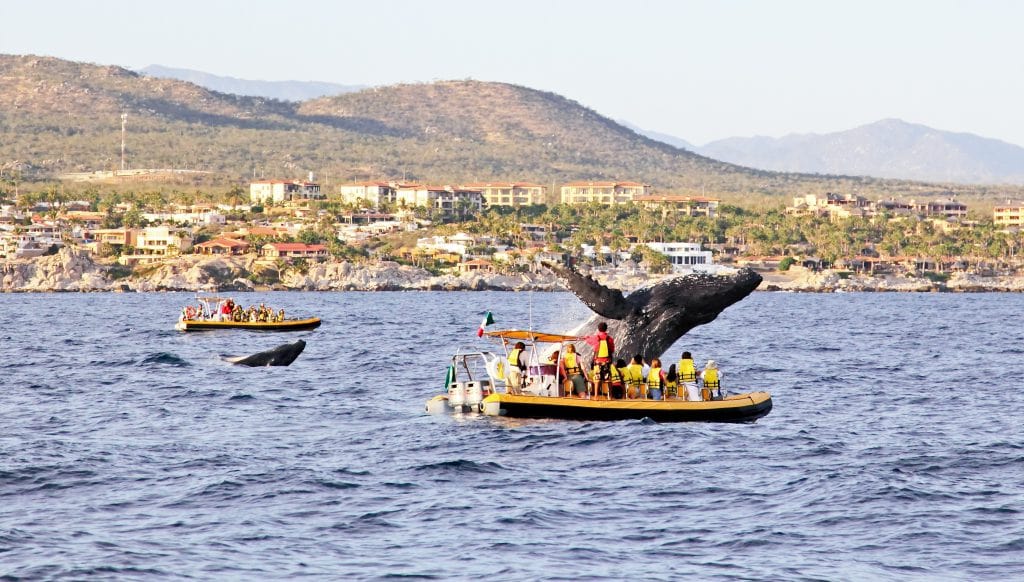
Los Cabos is often referred to as “paradise on earth” and during the winter months, not only will you get to experience the best weather of the year with daily high temperatures averaging 80°F, but also it’s the best time of year for whale watching. You can find many eco-adventures in Los Cabos, but whale watching in Cabo San Lucas is one of the most incredible winter activities that the region has to offer, especially when shared with family and friends.
All whale watching tours depart from the marina in Cabo San Lucas, which is approximately a 12-minute drive (2.5 miles) from Villa Del Palmar Beach Resort & Spa Cabo, Villa del Arco, and Villa La Estancia Cabo and a 25-minute drive (12.9 miles) from Villa La Valencia Beach Resort & Spa.
There are many reasons to get excited about whale watching in Los Cabos. From early December through to the beginning of April, both humpback and gray whales make their way to Baja California Sur. There are subtle differences between gray whales and humpback whales. Firstly their appearance is different. Gray whales are gray and humpbacks range from gray to black and have a white underbelly. Gray whales are smaller and weigh less than humpbacks and they can travel further distances of up to 12,700 miles. Gray whales don’t have dorsal fins but humpbacks do and they are bottom feeders whereas humpbacks feed right beneath the water’s surface on krill and fish such as salmon and pollock. And lastly, gray whales are not as acrobatic as humpbacks, although they still do emerge from the water.
Besides humpback and gray whales, there’s a slight chance you may also see blue whales or fin whales, which are less common, but sightings have been reported. And while out on the water, you are also likely to encounter bottlenose and spinner dolphins, sea lions, sea turtles, and Mobula rays.
Whale sharks can also be found in La Paz, Baja California Sur, from October through May. La Paz is a two-hour drive from Cabo San Lucas and a few tour companies offer the chance for you to swim with whale sharks. Check with your Member Services or Pre-Arrival agent to pre-book your tour and ask about tours that include resort pick-up and drop off.
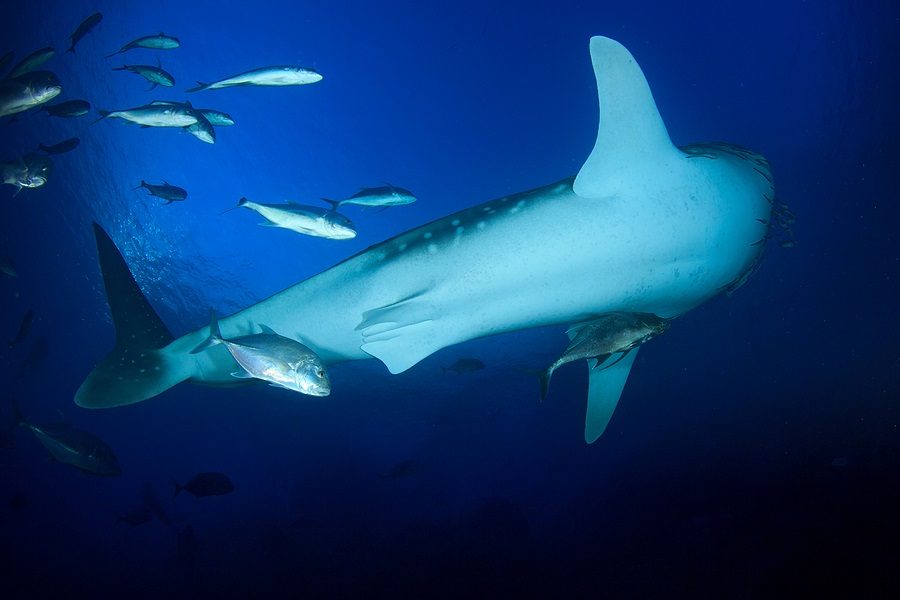
Islands of Loreto
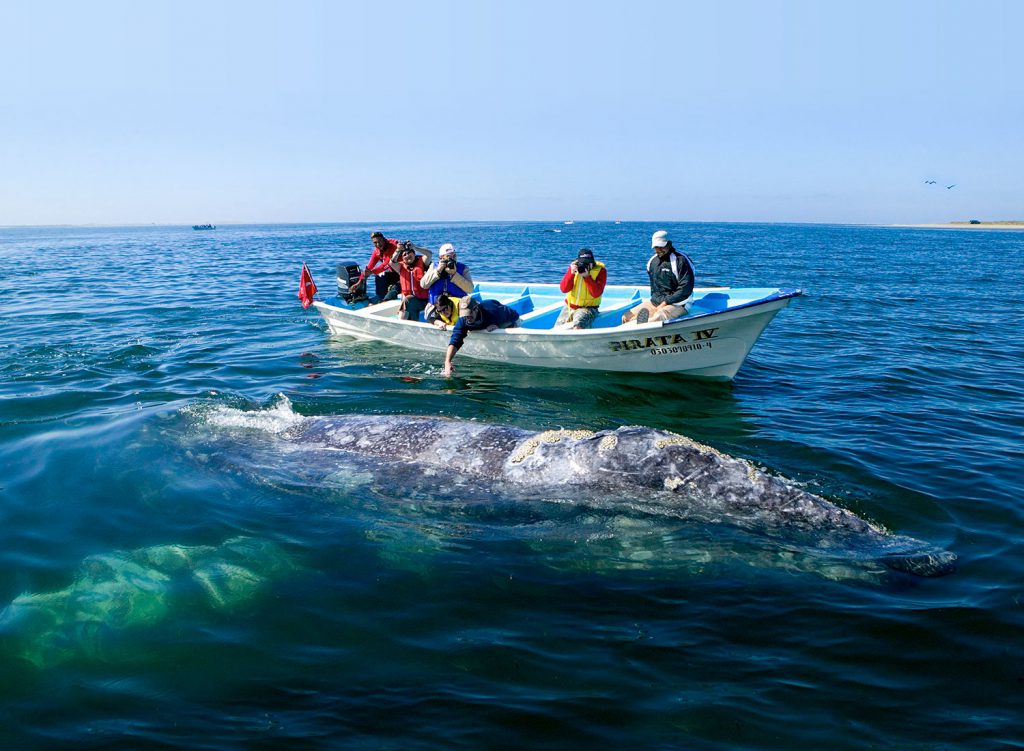
From December through March, whale watching season is in full swing at the Islands of Loreto and it’s one of the best places to go whale watching in the world since more than ten whale species can be sighted here. Aside from humpback and gray whales, you will also have the chance to spot blue, sei, sperm, finback, minke, pilot, tropical bottlenose, and orca whales.
The best place to see whales is at Loreto Bay National Park, ”Parque Nacional Bahía de Loreto”, which is only accessible by boat. Ask your Member Services or Pre-Arrival agent to book your tour prior to your arrival.
Cancun
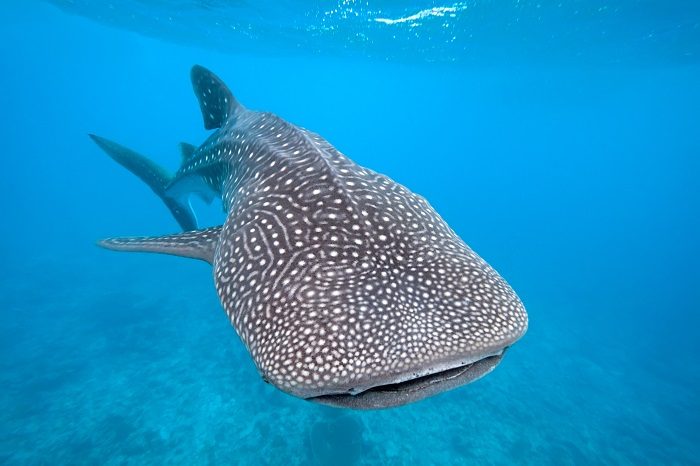
Humpback whales don’t migrate as far as Cancun. When they leave Alaska, they reemerge in the Baja California peninsula and then some continue all the way to Puerto Vallarta, but don’t make it as far as Quintana Roo.
However, swimming and snorkeling with whale sharks in Cancun is a popular water activity that you will want to add to your Mexico bucket list. Whale shark season is from June to September. Don’t let their name intimidate you, whale sharks are actually very gentle and playful and since they are filter feeders, they don’t bite. They are distinguished by their large size, measuring 40 feet long or more, and their white spots. Swimming alongside whale sharks is a truly mesmerizing experience. Combine it with a day trip to the beautiful Isla Mujeres with a laid back vibe, soft-sand beaches, and glimmering turquoise waters. There are many whale shark tours available in Cancun, Holbox, and Isla Mujeres and these can be arranged with your Member Services or Pre-Arrival agent prior to your vacation. Also, ask about arranging for your pick-up and drop off from the dock off the beach at Villa del Palmar Cancun.
So there’s all you need to know about the best spots to watch whales in Mexico.
These gigantic mammals are not only captivating to watch, but they are also very friendly and they may enjoy sighting you as much as you enjoy seeing them. Come and stay at your home away from home in Mexico and enjoy a journey to the warm beaches along with your whale friends.

